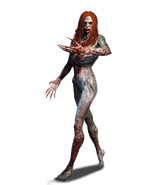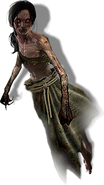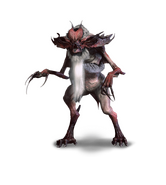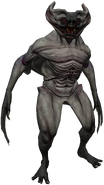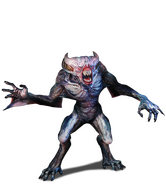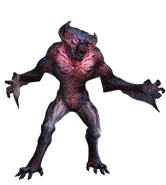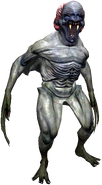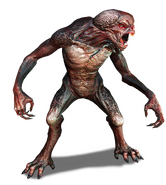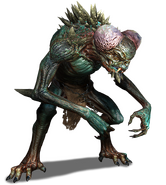| The moon shines bright, The vampire alights Swish, swish goes his cloak... Maiden, are you not afeared? |
|||
| - pg. 143 Baptism of Fire (U.K. edition) | |||
Vampire is a hypernym used to refer to a number of creatures that thrive on blood, which contains their victims' life force.
Quick Answers
What are the different grades of vampires in The Witcher universe?

What are some unique characteristics of vampires in Sapkowski's works?

What is the difference between a higher vampire and a lower grade vampire?

What are some of the popular vampire stereotypes that Sapkowski's works break from?

What is the role of blood in the life of a vampire in The Witcher universe?

Vampire species[]
- Higher grades:
- Higher Vampire
- Alp (Alpor in The Last Wish)
- Katakan
- Mula (Moola in The Last Wish)
- Bruxa
- Nosferat
- Lower grades:
Andrzej Sapkowski[]
Vampires in Sapkowski's works break with many popular stereotypes. In particular, vampire repellents such as holy water, crucifixes, garlic, wooden stakes, etc. are nothing but folklore within the Witcher saga. For example, Regis, the vampire who accompanies Geralt for a time, was once decapitated, staked through the heart, sprinkled with holy water and finally buried, but that did not prevent him from regenerating, albeit slowly.
Notable vampires[]
Facts and myths[]
As Regis traveled with Geralt, he clarified on a number of myths regarding vampires as such:
- Higher vampires don't need to drink blood to survive. Rather, it's like alcohol to them, in that they can become drunk from it. Additionally, drinking blood increases their strength.
- Certain higher vampires can turn invisible, bewitch with their gaze, and take on a bat form. They can also fly, but this ability can only be done during a full moon.
- They are not adversely affected by silver; although most vampires short of true Higher vampires can be wounded by it.
- A vampire bite does not turn the bitten creature into a vampire.
- Vampires are not undead or transformed creatures; they are born as vampires. The race of vampires appeared in the world after the Conjunction of the Spheres.
- Vampires don't burn up or turn to ash in sunlight. While it's not the best option for them given a choice, they adapted and can easily tolerate daylight.
- They cannot be seen in mirrors and other reflective surfaces.
- They don't cast shadows.
- Rushing water (rivers, etc.) poses no obstacle to their movement.
- Holy water, crucifixes, and garlic are ineffective against them.
- Partial bodily damage, such as a stake through the heart or decapitation, is only an inconvenience to them.
- Some can touch white hot metal with their bare hands without injury (this was the case with Regis).
Book quotes[]
"No. That never happens."
"In the case of higher vampires — never, I agree," Emiel Regis said softly. "From what I know alpors, moolas, bruxas and nosferats don't mutilate their victims. On the other hand, fleders and ekimmas are pretty brutal with their victims' remains."
The Witcher[]
There is at least two points where the game breaks with Sapkowski's written works regarding vampires:
- Garlic repels vampires
- Humans can be turned into vampires (Blue Eyes)
Notable vampires[]
The Witcher 2: Assassins of Kings[]
The Witcher 3: Wild Hunt[]
Beasts[]
Characters[]
Blood and Wine expansion[]
Of named higher vampires, Geralt can encounter up to four: Regis, Dettlaff van der Eretein, Orianna, and the Unseen Elder of Toussaint.
Throughout the main story quest La Cage au Fou, Regis and Geralt's exploration of Tesham Mutna reveals that vampires descend from three ancient tribes that arrived on the Continent during the Conjunction of the Spheres. A single portal opened from their world in caves underneath what later became Toussaint. The symbols of these tribes remain deep within the ruins, serving as reminders of their original realm.
The main story also expanded on the capabilities of a higher vampire: they are unique and have skills that accompanies it, and they are impregnable to most methods of extermination, practically giving higher vampires some form of immortality; and a set of vampiric codes that applies to all vampires, no matter the classification:
- A vampire killing another is forbidden and any vampire that does this is considered a traitor to the vampiric race.
- If a vampire sees another wounded, one can leave them alone, or help nurture them back to health.
Tribes[]
- Gharasham – remained in the west
- Ammurun – ventured beyond the sea
- Tdet – those who went east, beyond the Blue Mountains
Notes[]
- Black Blood is still effective to a degree.
- Weapons coated with Vampire Oil are very effective.
- The expansion changed how a true higher vampire can die. In particular, saying only higher vampires can truly kill another higher vampire.
- Magic really hurts them especially fire spells.
- A mixture of silver, meteorite, and dalvinite can be used to imprison even a higher vampire, such as Khagmar.




